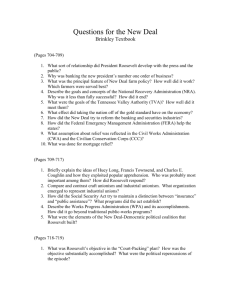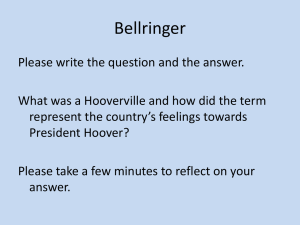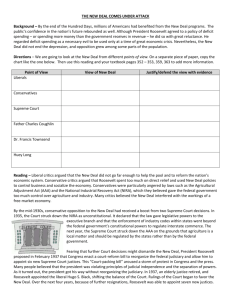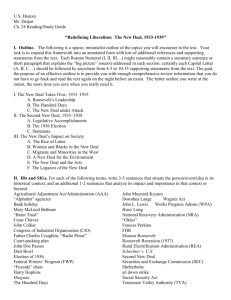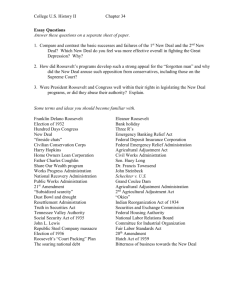Opponents Graphic Organizer
advertisement
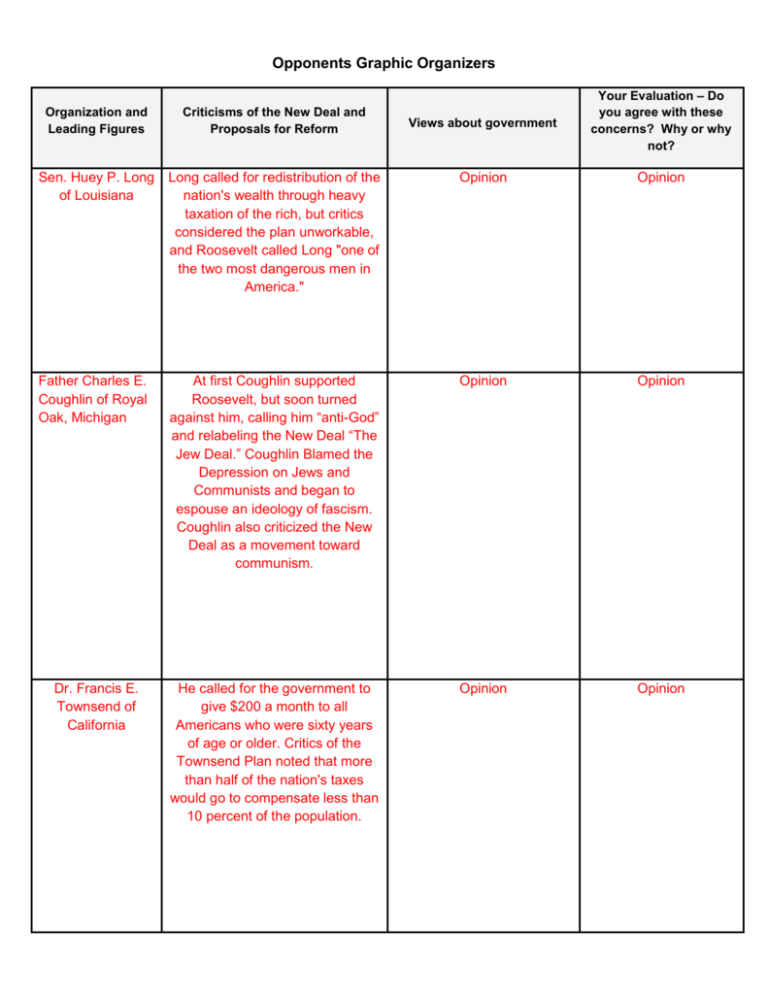
Opponents Graphic Organizers Views about government Your Evaluation – Do you agree with these concerns? Why or why not? Long called for redistribution of the nation's wealth through heavy taxation of the rich, but critics considered the plan unworkable, and Roosevelt called Long "one of the two most dangerous men in America." Opinion Opinion Father Charles E. Coughlin of Royal Oak, Michigan At first Coughlin supported Roosevelt, but soon turned against him, calling him “anti-God” and relabeling the New Deal “The Jew Deal.” Coughlin Blamed the Depression on Jews and Communists and began to espouse an ideology of fascism. Coughlin also criticized the New Deal as a movement toward communism. Opinion Opinion Dr. Francis E. Townsend of California He called for the government to give $200 a month to all Americans who were sixty years of age or older. Critics of the Townsend Plan noted that more than half of the nation's taxes would go to compensate less than 10 percent of the population. Opinion Opinion Organization and Leading Figures Criticisms of the New Deal and Proposals for Reform Sen. Huey P. Long of Louisiana The Socialist Party of America, led by Norman Thomas Although FDR implemented nearly all the Socialists’ programs, including social insurance for the unemployed and elderly, national medical insurance, federal relief payments to the unemployed, federal jobs programs, a minimum hourly wage, the right for workers to bargain collectively in unions, a federal program to refinance people's homes and farms, repeal of Prohibition, and arms reduction, they felt he only did it to “save capitalism” rather than to promote socialism. Thus, Socialists called for more relief spending, a thirtyhour workweek, and more aid for farmers. Opinion Opinion American Liberty League (ALL) The ALL (mainly supported by wealthy businessmen) claimed that the New Deal threatened the constitutional system of checks and balances by concentrating power in the chief executive, the ALL also opposed the New Deal's monetary policy, its deficit spending, its progressive taxation of businesses, and its efforts to enlarge government in general. Opinion Opinion NEW DEAL OPPONENTS Group 1: Share-Our-Wealth Societies/ Huey Long The greatest challenge to Roosevelt and the New Deal in the mid 1930s proved to be Sen. Huey P. Long of Louisiana, whose "Share-Our-Wealth" clubs, organized in early 1934, spread rapidly across the country. Millions of Americans supported Long's proposals. Calling for redistributing the nation's wealth through heavy taxation of the rich, Long's plan guaranteed every American an annual income of twenty-five hundred dollars (a middle-class income in the 1930s) and a "homestead allowance" of five thousand dollars. Critics considered the plan unworkable, and Roosevelt called Long "one of the two most dangerous men in America." Nevertheless, a poll conducted in mid 1935 found that Long would get 10 percent of the vote if he were to run for president. Soon after Long was assassinated in September 1935, the "Share-Our-Wealth" movement collapsed. Group 2: The National Union for Social Justice / Father Coughlin Another challenge to the programs and policies of the New Deal came from a "radio priest" in Royal Oak, Michigan. A Catholic priest named Father Charles E. Coughlin, who had been broadcasting his radio show since the mid 1920s, began attacking communism. The popularity of his show grew enormously during the early days of the Depression. In 1934 Coughlin received more mail than any other American, and an estimated 30 million to 45 million Americans listened to his show each week. At first Coughlin supported Roosevelt. During the 1932 election he told his audience that it was "Roosevelt or ruin," and in 1933 he said that "the New Deal is Christ's deal." Yet Coughlin soon turned against Roosevelt. Blaming the Depression on Jews and Communists, he began to espouse what analysts of his broadcasts have called an ideology of fascism. By 1935 Coughlin was calling Roosevelt "anti-God," and he relabeled the New Deal "The Jew Deal." Coughlin also criticized the New Deal as a movement toward communism. In 1934 Coughlin began the National Union for Social Justice, which had half a million members at its peak, and in 1935 he helped found the Union Party to challenge Roosevelt's bid for reelection. Group 3: The Townsend Plan In1934 Dr. Francis E. Townsend of California also mounted a challenge to the New Deal, calling for the government to give two hundred dollars a month to all Americans who were sixty years of age or older. Critics of the Townsend Plan noted that more than half of the nation's taxes would go to compensate less than 10 percent of the population. Nonetheless, by January 1935 there were more than three thousand Townsend clubs claiming half a million members each. A Townsend Plan bill was introduced in Congress, but the Social Security Act of 1935—developed in part because of the political pressure brought to bear on the administration by Townsend's supporters—dissipated much of the movement's energy. Group 4: The Socialist Challenge to the New Deal The Socialist Party of America, led by Norman Thomas, contained within it both reformist and revolutionary elements. During the 1920s the party had often emphasized the need for revolutionary change, but in the 1932 election, with Thomas as their presidential candidate, Socialists offered a largely reformist platform. They hoped these reforms would lead toward a restructuring of the nation's polity. In their 1932 platform Socialists called for social insurance for the unemployed and elderly, as well as for national medical insurance, federal relief payments to the unemployed, federal jobs programs, a minimum hourly wage, the right for workers to bargain collectively in unions, a federal program to refinance people's homes and farms, repeal of Prohibition, and arms reduction. When Franklin D. Roosevelt was elected president (on a much more conservative Democratic Party platform), the Socialists were shocked to find that he implemented almost all of their programs. "What cut the ground pretty completely from under us was," Thomas said, "Roosevelt in a word/' Yet Thomas and other Socialists believed that Roosevelt had implemented reforms to save capitalism rather than to cultivate socialism. In 1936 the Socialist Party called for further relief spending, a thirty-hour workweek, and more aid for farmers. Whereas Thomas had received 881,951 votes in the presidential election of 1932, he received only 187,720 votes in 1936. Factional fights between Old Guard Socialists and the revolutionary left wing of the party further weakened the organization in the late 1930s. By 1938 party membership was down to seven thousand (from a high of around twenty-one thousand in 1934). While they could claim success in seeing the implementation of many of the reforms they had proposed, Socialists were disheartened by the lack of growth in their movement. Group 5: American Liberty League (ALL) The American Liberty League (ALL) was the greatest voice of political conservatism during the second half of the 1930s. During its six-year existence the ALL gained support from some of the wealthiest businessmen and professionals in the United States. Among them were Irenee du Pont of the Du Pont company; Nathan Miller, head of U.S. Steel; Edward F. Hutton of General Foods; and John Jacob Rascob, former director of General Motors and onetime head of the Democratic Party. Among other disillusioned Democrats active in the ALL were two former Democratic presidential candidates: John W. Davis, who lost to Calvin Coolidge in 1924, and Alfred E. Smith, who lost to Hoover in 1928. The ALL offered cogent conservative criticism of the New Deal. Its stated purpose was "to defend and uphold the Constitution … [and] to teach the duty of government to protect individual and group initiatives.…" Claiming that the New Deal threatened the constitutional system of checks and balances by concentrating power in the chief executive, the ALL also opposed the New Deal's monetary policy, its deficit spending, its progressive taxation of businesses, and its efforts to enlarge government in general. Though the ALL suffered from its popular image as a club for millionaires and did not gain wide popular support, its membership reached almost 125,000 at its height, prior to the election in 1936. The league foundered after Roosevelt's decisive electoral victory that year. Alf Landon, Roosevelt's Republican opponent in that election, said that an endorsement from the ALL was "the kiss of death."
